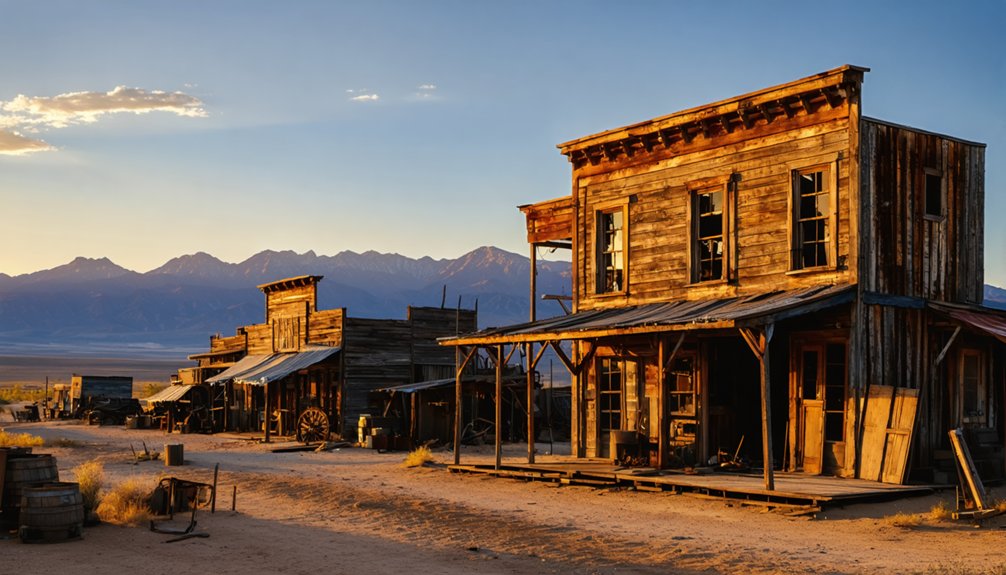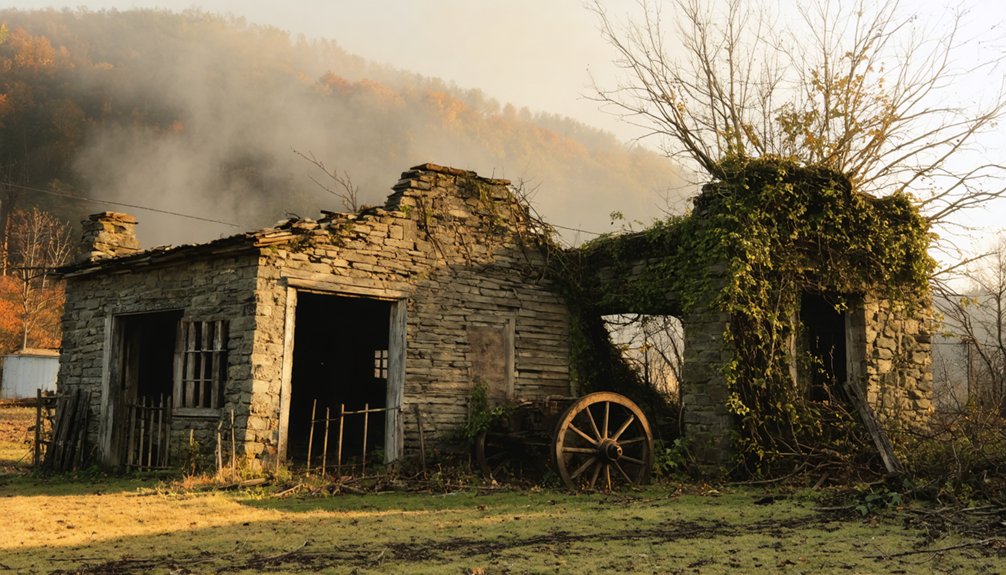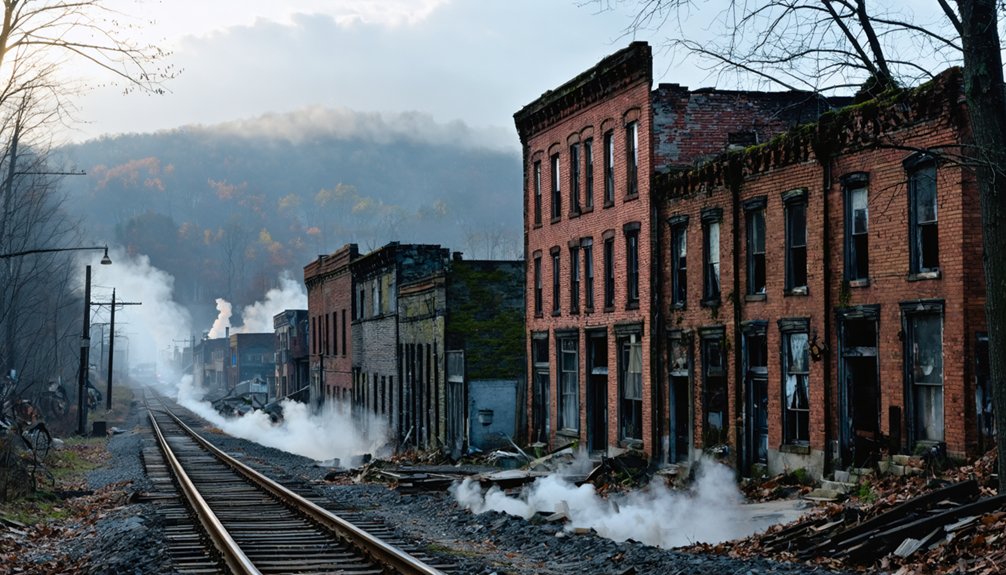You’ll find America’s most haunting Civil War ghost towns scattered across the nation, from Cahaba, Alabama’s first capital turned Confederate prison, to Montana’s gold rush settlements of Bannack and Virginia City. These abandoned towns showcase preserved period architecture, mining heritage, and tales of political strife. St. Elmo, Colorado and Goldfield, Nevada offer glimpses into the 1880s mining boom, while sites like Batsto Village preserve essential industrial history. Their crumbling ruins and spectral legends hold deeper secrets of America’s transformative era.
Key Takeaways
- Cahaba, Alabama stands as a prime example, transitioning from state capital to Confederate prison before devastating floods led to abandonment.
- Virginia City, Montana showcases intense Civil War-era conflicts between Union and Confederate sympathizers, leading to vigilante justice.
- Ghost towns reveal economic shifts from wartime industries to post-war decline, often preserving original architecture and artifacts.
- Many abandoned towns feature documented paranormal activity connected to Civil War tragedies and military conflicts.
- Historic preservation efforts maintain these sites as educational resources about Civil War history and 19th-century American life.
The Lost Capital: Cahaba, Alabama’s Haunted Legacy
Once a bustling river town at the confluence of rivers, Cahaba stood as Alabama’s first state capital before being abandoned to the ghosts of its past. The town’s ancient Native mounds reveal evidence of earlier settlements that existed long before its brief tenure as state capital.
St. Elmo: Colorado’s Wild West Mining Heritage
When you visit St. Elmo’s well-preserved ruins, you’ll find the remnants of a once-thriving mining town that grew to over 2,000 residents during its 1880s peak, complete with five hotels, multiple restaurants, and the essential Mary Murphy Mine.
Today, visitors can explore 43 surviving buildings that stand as testament to the town’s rich history.
The town’s economic significance depended heavily on the Denver, South Park & Pacific Railroad, which transported precious metals and supplies until its final departure in 1926.
You can still explore many original structures today, including the iconic general store maintained by the Stark family for decades after the town’s abandonment, though several historic buildings were tragically lost to a fire in 2002. The area became a major tourist destination after Anna Stark shifted her focus to renting tourist cabins, marking a new chapter in St. Elmo’s history.
Mining Operations and Commerce
Deep in Colorado’s rugged terrain, St. Elmo’s mining techniques transformed a remote mountain outpost into a bustling hub of commerce. The Mary Murphy Mine led the economic revival, extracting 220,000 ounces of gold between 1870 and 1925, while shipping up to 75 tons of ore daily to Alpine smelters.
You’ll find evidence of the town’s innovative engineering in the water flumes that powered mining operations and sustained nearly 2,000 residents. The Denver, South Park & Pacific Railroad’s arrival amplified St. Elmo’s growth, connecting the town’s 150 patented mine claims to broader markets. Extensive wooden flume systems transported vital water supplies through the mountainous terrain for ore processing and daily operations.
At its peak, you could visit saloons, dance halls, banks, and general stores in the thriving business district. The town’s prosperity was fueled by at least 50 active mines operating simultaneously.
However, the devastating 1890 fire, followed by the Alpine Tunnel’s closure in 1910, marked the beginning of St. Elmo’s decline.
Ghost Stories and Legends
Among St. Elmo’s most compelling features, you’ll find a rich tapestry of ghostly encounters centered around Annabelle “Dirty Annie” Stark, a descendant of the town’s original settlers. As one of Colorado’s most famous spectral protectors, she’s known for guarding the town against vandals even after her death. At 9,900 feet elevation, the thin mountain air adds to the eerie atmosphere that visitors often describe.
The paranormal activity you might experience includes:
- Sudden temperature drops near the Home Comfort Hotel
- Unexplained door slammings in abandoned structures
- Moving shadows throughout the general store
- Mysterious noises in former mining buildings
- Ghostly apparitions during snowmobile excursions
The Stark family’s persistence in staying after the town’s abandonment created the foundation for these haunting tales.
You’ll discover that the town’s wild history, from its rugged 1880 settlement to its bustling 2,000-resident peak, provides the perfect backdrop for its supernatural reputation. The town’s economic prosperity once relied on the legendary Mary Murphy Mine, which dominated local mining operations for half a century.
Bannack: Montana’s Gold Rush Time Capsule
You’ll find Bannack’s remarkably preserved buildings, including original wooden sidewalks and the iconic Methodist church, standing as evidence to the 1860s gold rush that sparked this frontier settlement.
The town’s mining operations centered around Grasshopper Creek, where placer gold deposits attracted thousands of fortune seekers and led to the construction of sturdy wooden and brick structures that have withstood over 150 years of Montana weather. The exceptionally pure gold, measuring 99.5% purity, drew prospectors from across the nation. Today, visitors can explore 60 preserved buildings that showcase the authentic architecture of this historic mining town.
Local legends tell of ghostly encounters in these historic buildings, particularly in the Hotel Meade and around the gallows where vigilantes executed Sheriff Henry Plummer and his band of outlaws.
Mining Operations and Architecture
Montana’s first major gold rush town, Bannack, sprang to life in 1862 following the discovery of exceptionally pure gold deposits along Grasshopper Creek.
You’ll find evidence of mining technology evolution, from simple placer mining to advanced hydraulic operations and dredging. The town’s architectural preservation showcases over 60 authentic frontier structures, offering you a raw glimpse into 1860s Western life.
Key features of Bannack’s preserved landscape include:
- Original wooden and brick buildings standing in their authentic positions
- Narrow streets characteristic of mining camp layouts
- Historic Methodist church from the 1870s
- Visible dredge buckets and modified riverbeds
- Mining cabins, saloons, and public buildings frozen in time
The site remains a symbol of the untamed spirit of America’s gold rush era, maintaining its rugged, authentic character through careful preservation efforts.
Ghost Stories and Legends
When darkness falls over Bannack’s abandoned streets, the spirits of its tumultuous past come alive through haunting tales and unexplained phenomena.
You’ll hear spectral narratives of Henry Plummer, the controversial sheriff hanged by vigilantes, who’s said to roam the town seeking vindication.
The Hotel Meade, once a courthouse and hospital, stands as a focal point for ghostly encounters, where apparitions of women in period dress frequently appear.
The violent legacy of the Montana Vigilantes, who executed 24 alleged gang members in just 42 days, echoes through the preserved buildings.
Near the gallows, you’ll sense the restless spirits of those who met swift justice.
Native American conflicts add another layer to these supernatural tales, while the town’s sudden decline in the mid-1900s seems to have frozen these haunting moments in time.
Virginia City: The Crown Jewel of Montana Ghost Towns
Nestled in the heart of Montana’s historic Alder Gulch, Virginia City emerged as one of America’s most significant gold rush boomtowns after prospectors William Fairweather and Henry Edgar struck gold in 1863.
Within weeks, thousands of fortune seekers flooded the area, transforming the remote valley into a bustling hub of over 30,000 inhabitants.
The explosive rush for riches transformed an untamed Montana valley into a sprawling city of hopeful prospectors seemingly overnight.
As Montana’s territorial capital, Virginia City witnessed:
- Intense political conflicts between Union and Confederate sympathizers
- The rise of vigilante justice targeting Southern-aligned settlers
- A thriving commercial district with authentic period architecture
- A dramatic economic decline after the railroad bypassed the town
- A remarkable preservation effort by the Boveys in the 1950s
Today, you’ll experience one of the West’s best-preserved ghost towns, where original buildings and artifacts tell the story of Montana’s gold rush era.
Nevada City’s Hidden Mining Treasures

You’ll discover that Nevada City’s gold rush history began in 1863 when placer miners flocked to Alder Gulch, establishing one of America’s richest placer mining settlements.
While the town’s population swelled to 10,000 during peak mining operations, the gold deposits were depleted by 1876, leading to the town’s abandonment.
Today, you can explore 108 historic buildings connected by wooden boardwalks, including 14 original structures that showcase the architectural style of Montana’s mining era.
Gold Rush Mining Operations
Deep within California’s storied Gold Country, Nevada City’s mining legacy began in 1849 when three prospectors – John Pennington, William McCaib, and Thomas Cross – discovered gold along Deer Creek.
Initially known as Deer Creek Diggings, the settlement quickly transformed from a tent city into a thriving mining hub, with gold mining techniques evolving from simple placer mining to advanced hydraulic and hardrock operations.
The district’s diverse mining methods included:
- Placer mining along creek beds and river gravels
- Hydraulic mining that washed away entire hillsides
- Hardrock mining through 367 miles of underground shafts
- Drift mining in the rich Harmony Channel
- Quartz lode mining yielding up to $600,000 annually
Historic Buildings Today
Standing as proof of Nevada City’s golden past, the town’s historic mining buildings offer visitors a remarkable window into 19th-century industrial innovation.
You’ll find over 150 protected brick structures in the downtown district, each maintaining its architectural integrity through strict preservation ordinances.
At Empire Mine State Historic Park, you’re free to explore the state’s largest gold mine complex, featuring 367 miles of tunnels and preserved surface buildings.
The Le Compton mine, once owned by George Hearst, showcases original structures including the assay office and blacksmith shop.
You won’t want to miss the Nevada City Powerhouse, where century-old turbines and generators still stand as evidence of early hydroelectric innovation.
The town’s historic preservation efforts guarantee these industrial landmarks remain authentic, allowing you to step directly into California’s mining heritage.
Ruby: Arizona’s Forgotten Frontier Settlement
Nestled in the rugged terrain of southern Arizona, Ruby began its tumultuous history as a modest mining camp in the late 1870s, initially bearing the name Montana Camp after its rich mineral vein.
By the 1930s, you’d find a thriving community of 1,200 residents, with Ruby’s legacy as Arizona’s leading zinc and lead producer firmly established. The mining decline came swiftly in 1940, leaving the settlement abandoned by 1941.
Today, you’ll discover one of Arizona’s best-preserved ghost towns, featuring:
- The historic Ruby Jail with its adobe construction
- A unique lake formed from mining tailings
- More than two dozen original structures
- The remains of the once-bustling mercantile
- Numerous unmarked graves from the mining era
Despite its violent past, Ruby stands as a symbol of frontier resilience, protected by private ownership and listed on the National Register of Historic Places.
The Mysterious Ruins of Cahawba

While Arizona’s ghost towns tell tales of mineral wealth, Alabama’s first state capital reveals a more complex story of political power and Civil War tragedy.
You’ll find the haunting Cahawba ruins nestled along the Alabama River, where a once-thriving town served as the state’s political center from 1820 to 1826. Built atop ancient Native American settlements, Cahawba flourished as a cotton distribution hub until the Civil War transformed it into a Confederate prison known as Castle Morgan, holding 3,000 Union soldiers in dire conditions.
Once a bustling capital and cotton hub, Cahawba fell from grace to become a grim Confederate prison holding thousands.
Two devastating floods in 1865 accelerated the town’s decline, and by 1866 it had lost its county seat status.
Today, you can explore the archaeological park‘s brick remnants, cemetery grounds, and historic sites that stand as silent witnesses to Alabama’s turbulent past.
Goldfield: A Tale of Western Mining Glory
The discovery of gold in 1902 by Shoshone prospector Tom Fisherman sparked one of Nevada’s most dramatic mining booms, transforming Goldfield from a rugged camp into the state’s largest city.
The mining legacy of this remarkable town reached its peak in 1906 with 30,000 residents working around the clock to extract precious ore.
Key developments in Goldfield’s history include:
- Arrival of the Tonopah and Goldfield Railroad in 1905
- Formation of the Goldfield Consolidated Mining Company in 1908
- Labor disputes requiring federal intervention in 1907
- Devastating flash flood of 1913
- Catastrophic fire of 1923 destroying 53 blocks
You’ll find Goldfield’s decline was as dramatic as its rise.
After the mining company ceased operations in 1918, the population dwindled.
Today, this ghost town preserves the memory of America’s last great gold rushes.
Bodie’s Preserved Mining Legacy

Among California’s most remarkable ghost towns, Bodie stands as a tribute to America’s mining heritage, preserving a raw glimpse into 19th-century frontier life. Following its 1859 discovery, this mining boomtown rapidly grew to house 8,000 residents and produced an astounding $38 million in gold and silver between 1877 and 1882.
The town’s authentic Bodie artifacts remain exactly as residents left them – plates on counters, belongings on tables – frozen in time through a preservation approach known as “arrested decay.” You’ll find over 110 original buildings showcasing classic Bodie architecture, from the weathered church to the abandoned saloon.
Though devastating fires destroyed 90% of the town by 1932, Bodie’s designation as a National Historic Landmark in 1961 guarantees its legacy endures at 8,379 feet above sea level.
Batsto Village: Iron Works to Ghost Town
Founded in 1766 by Charles Read, Batsto Village emerged as an important industrial hub at the convergence of abundant natural resources along the Batsto River.
Batsto Village’s history showcases America’s early industrial might, transforming from a thriving ironworks to a preserved ghost town. You’ll discover how this settlement played a significant role in forging America’s independence by supplying the Continental Army with essential munitions.
The ironworks legacy of Batsto includes:
- Strategic exemption of workers from military service
- Production of artillery fittings and camp kettles
- Self-sustaining village development under William Richards
- Shift to glass manufacturing after iron industry decline
- Final transformation into Joseph Wharton’s agricultural estate
Today, you can explore over 40 historic buildings within Wharton State Forest, where Batsto stands as a representation of American industrial innovation and resilience.
Frequently Asked Questions
Are Ghost Towns Legally Protected From Treasure Hunters and Metal Detectors?
With $100,000 fines per violation, you’ll face strict ghost town preservation laws. Most treasure hunting and metal detecting requires permits, while federal ARPA regulations protect historic sites from unauthorized digging.
What Survival Gear Should Visitors Bring When Exploring Remote Ghost Towns?
You’ll need survival essentials like GPS, maps, flashlights, first-aid kit, water purification, and emergency shelter. Don’t forget safety precautions: sturdy boots, protective clothing, dust masks, and communication devices.
Can You Legally Collect Artifacts Found in Civil War Ghost Towns?
You can’t legally collect artifacts without proper permits and landowner permission. Artifact laws protect historical preservation, and violations can result in hefty fines. Surface collection remains restricted on federal/state lands.
Which Ghost Towns Are Considered the Most Paranormally Active?
With 51,000 casualties, Gettysburg leads America’s most haunted locations, followed by Silver City’s flying objects and Garnet’s phantom voices. You’ll find frequent spectral sightings at these paranormally charged towns.
Do Any Ghost Towns Still Have Year-Round Permanent Residents?
You’ll find year-round residents in several ghost town communities today, like Centralia, Pennsylvania with seven inhabitants, Bodie, California with park staff, and St. Elmo, Colorado maintaining about forty buildings.
References
- https://www.loveexploring.com/gallerylist/131658/abandoned-in-the-usa-92-places-left-to-rot
- https://en.wikipedia.org/wiki/Wikipedia:WikiProject_Ghost_towns
- https://www.traxroot.com/post/15-spookiest-abandoned-american-ghost-towns-safeguard-your-vehicle
- https://freepages.rootsweb.com/~gtusa/history/
- https://www.mentalfloss.com/geography/american-ghost-towns-can-still-walk-through
- https://blog.batchgeo.com/ghost-towns/
- https://www.visittheusa.com/experience/5-us-ghost-towns-you-must-see
- https://en.wikipedia.org/wiki/Ghost_town
- https://www.christywanders.com/2024/08/top-ghost-towns-for-history-buffs.html
- https://en.wikipedia.org/wiki/Wikipedia:WikiProject_Ghost_towns/Assessment



